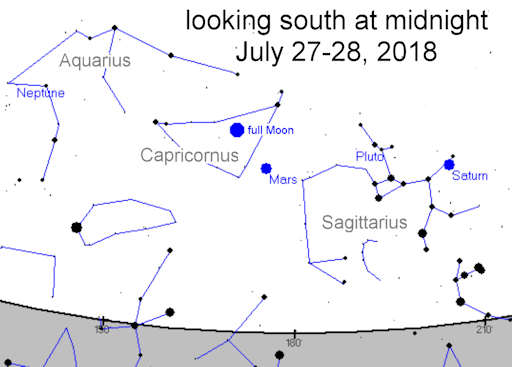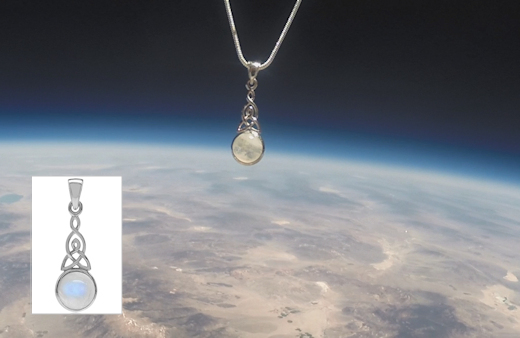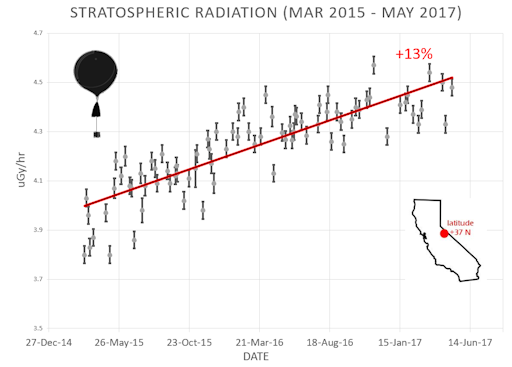 | | | Switch to: Europe, USA, New Zealand, Antarctica Credit: NOAA/Ovation  Planetary K-index Planetary K-index
Now: Kp= quiet
24-hr max: Kp= quiet
explanation | more data
Interplanetary Mag. Field
Btotal: 3.2 nT
Bz: -2.4 nT south
more data: ACE, DSCOVR
Updated: Today at 2346 UT  Coronal Holes: 24 Jul 18 Coronal Holes: 24 Jul 18 
Solar wind flowing from this large coronal hole should reach Earth on July 24th or 25th. Credit: SDO/AIA  Noctilucent Clouds The season for noctilucent clouds in he northern hemisphere is underway. Check here daily for the latest images from NASA's AIM spacecraft. Switch view: Europe, USA, Asia, Polar Updated at: 07-24-2018 13:55:02 Noctilucent Clouds The season for noctilucent clouds in he northern hemisphere is underway. Check here daily for the latest images from NASA's AIM spacecraft. Switch view: Europe, USA, Asia, Polar Updated at: 07-24-2018 13:55:02  SPACE WEATHER
NOAA Forecasts | | Updated at: 2018 Jul 24 2200 UTC FLARE | 0-24 hr | 24-48 hr | CLASS M | 01 % | 01 % | CLASS X | 01 % | 01 % |  Geomagnetic Storms: Geomagnetic Storms:
Probabilities for significant disturbances in Earth's magnetic field are given for three activity levels: active, minor storm, severe storm Updated at: 2018 Jul 24 2200 UTC Mid-latitudes | 0-24 hr | 24-48 hr | ACTIVE | 30 % | 20 % | MINOR | 15 % | 05 % | SEVERE | 01 % | 01 % | High latitudes | 0-24 hr | 24-48 hr | ACTIVE | 15 % | 15 % | MINOR | 30 % | 25 % | SEVERE | 45 % | 30 % | | | |  | | | | | | | | | | | All-inclusive Northern Lights trips in Tromsø, Norway. Small groups, big experiences! Highly qualified guides ensure unique and unforgettable adventures with a personal touch. Visit Explore the Arctic | | | THE SOLAR WIND HAS ARRIVED: As predicted, a stream of solar wind has enveloped Earth on July 24th with wind speeds near 600 km/s. First contact with the stream sparked a brief outburst of summertime auroras over Canada. An anticipated G1-class geomagnetic storm has yet to materialize, but it is too soon to rule out such a storm. The gaseous material is flowing from a broad hole in the sun's atmosphere--so broad that Earth will remain inside the stream for 2 or 3 more days. Free: Aurora Alerts. LUNAR ECLIPSE AND MARTIAN CONJUNCTION: Friday, July 27th, is a big night for astronomy. Three beautiful things will be happening almost simultaneously. First, Mars will be at opposition--directly opposite the sun and making a 15-year close approach to Earth. Second, Mars and the full Moon will be in conjunction--less than 10 degrees apart. Third, the Moon will pass through the shadow of Earth, producing the longest lunar eclipse in a century: Graphic artist Larry Koehn of ShadowandSubstance.com created this animation of the eclipse. Almost everyone on Earth (except North Americans) can see the eclipse as the sunset-colored shadow of our planet swallows the Moon for almost 2 hours. During totality, the Moon will turn almost the same red color as Mars right beside it--an incredible sight. [eclipse visibility map]
Because Mars is opposite the sun, it will rise at sunset and stay up all night long. The best time to look is around midnight when the Moon-Mars pair will be at their highest in the sky. Burnt-orange Mars will have no trouble being seen through the glare of the Moon because Mars itself is so bright--almost three times brighter than Sirius, the brightest star in the sky. 
People in North America will not be able to see the eclipse. The shadow play happens mostly on the opposite side of the world. They can, however, witness the conjunction. Swinging a backyard telescope between the Moon and Mars in quick succession will reveal the dusty-red martian disk alongside lunar mountains and craters. It's a special night. Enjoy the show!
Realtime Space Weather Photo Gallery
FLY ME TO THE MOONSTONE: Are you looking for a far-out gift? Nothing says "I love you" like a moonstone from the edge of space. On June 12th, the students of Earth to Sky Calculus flew this moonstone wrapped in a sterling silver Celtic love knot 34.1 km (111,877 feet) above Earth's surface: 
You can have it for $119.95. The students are selling these pendants to support their cosmic ray ballooning program. Each one comes with a greeting card showing the item in flight and telling the story of its journey to the edge of space. Sales support the Earth to Sky Calculus cosmic ray ballooning program and hands-on STEM research. Far Out Gifts: Earth to Sky Store
All sales support hands-on STEM education
Realtime Noctilucent Cloud Photo Gallery
Realtime Aurora Photo Gallery
Every night, a network of NASA all-sky cameras scans the skies above the United States for meteoritic fireballs. Automated software maintained by NASA's Meteoroid Environment Office calculates their orbits, velocity, penetration depth in Earth's atmosphere and many other characteristics. Daily results are presented here on Spaceweather.com. On Jul. 24, 2018, the network reported 24 fireballs.
(22 sporadics, 1 psi Cassiopeid, 1 alpha Capricornid)  In this diagram of the inner solar system, all of the fireball orbits intersect at a single point--Earth. The orbits are color-coded by velocity, from slow (red) to fast (blue). [Larger image] [movies] Potentially Hazardous Asteroids ( PHAs) are space rocks larger than approximately 100m that can come closer to Earth than 0.05 AU. None of the known PHAs is on a collision course with our planet, although astronomers are finding new ones all the time. On July 24, 2018 there were 1912 potentially hazardous asteroids.
 | Recent & Upcoming Earth-asteroid encounters: | Asteroid | Date(UT) | Miss Distance | Velocity (km/s) | Diameter (m) | | 2018 NQ1 | 2018-Jul-19 | 16.4 LD | 6 | 32 | | 2018 OF | 2018-Jul-19 | 14.7 LD | 14 | 49 | | 2018 NE1 | 2018-Jul-21 | 10.1 LD | 14.2 | 73 | | 2018 NF4 | 2018-Jul-21 | 18.8 LD | 12.8 | 114 | | 2018 OL | 2018-Jul-22 | 11.5 LD | 16.1 | 57 | | 2018 NR1 | 2018-Jul-27 | 17.1 LD | 5.1 | 35 | | 2018 LQ2 | 2018-Aug-27 | 9.4 LD | 1.5 | 39 | | 2016 GK135 | 2018-Aug-28 | 16.8 LD | 2.8 | 9 | | 2016 NF23 | 2018-Aug-29 | 13.3 LD | 9 | 93 | | 1998 SD9 | 2018-Aug-29 | 4.2 LD | 10.7 | 51 | | 2018 DE1 | 2018-Aug-30 | 15.2 LD | 6.5 | 28 | | 2001 RQ17 | 2018-Sep-02 | 19.3 LD | 8.3 | 107 | | 2015 FP118 | 2018-Sep-03 | 12.3 LD | 9.8 | 490 | | 2017 SL16 | 2018-Sep-20 | 8.5 LD | 6.4 | 25 | Notes: LD means "Lunar Distance." 1 LD = 384,401 km, the distance between Earth and the Moon. 1 LD also equals 0.00256 AU. MAG is the visual magnitude of the asteroid on the date of closest approach. | | Cosmic Rays in the Atmosphere |
Readers, thank you for your patience while we continue to develop this new section of Spaceweather.com. We've been working to streamline our data reduction, allowing us to post results from balloon flights much more rapidly, and we have developed a new data product, shown here: 
This plot displays radiation measurements not only in the stratosphere, but also at aviation altitudes. Dose rates are expessed as multiples of sea level. For instance, we see that boarding a plane that flies at 25,000 feet exposes passengers to dose rates ~10x higher than sea level. At 40,000 feet, the multiplier is closer to 50x. These measurements are made by our usual cosmic ray payload as it passes through aviation altitudes en route to the stratosphere over California. What is this all about? Approximately once a week, Spaceweather.com and the students of Earth to Sky Calculus fly space weather balloons to the stratosphere over California. These balloons are equipped with radiation sensors that detect cosmic rays, a surprisingly "down to Earth" form of space weather. Cosmic rays can seed clouds, trigger lightning, and penetrate commercial airplanes. Furthermore, there are studies ( #1, #2, #3, #4) linking cosmic rays with cardiac arrhythmias and sudden cardiac death in the general population. Our latest measurements show that cosmic rays are intensifying, with an increase of more than 13% since 2015: 
Why are cosmic rays intensifying? The main reason is the sun. Solar storm clouds such as coronal mass ejections (CMEs) sweep aside cosmic rays when they pass by Earth. During Solar Maximum, CMEs are abundant and cosmic rays are held at bay. Now, however, the solar cycle is swinging toward Solar Minimum, allowing cosmic rays to return. Another reason could be the weakening of Earth's magnetic field, which helps protect us from deep-space radiation. The radiation sensors onboard our helium balloons detect X-rays and gamma-rays in the energy range 10 keV to 20 MeV. These energies span the range of medical X-ray machines and airport security scanners. The data points in the graph above correspond to the peak of the Reneger-Pfotzer maximum, which lies about 67,000 feet above central California. When cosmic rays crash into Earth's atmosphere, they produce a spray of secondary particles that is most intense at the entrance to the stratosphere. Physicists Eric Reneger and Georg Pfotzer discovered the maximum using balloons in the 1930s and it is what we are measuring today. | | The official U.S. government space weather bureau | | | The first place to look for information about sundogs, pillars, rainbows and related phenomena. | | | Researchers call it a "Hubble for the sun." SDO is the most advanced solar observatory ever. | | | 3D views of the sun from NASA's Solar and Terrestrial Relations Observatory | | | Realtime and archival images of the Sun from SOHO. | | | from the NOAA Space Environment Center | | | fun to read, but should be taken with a grain of salt! Forecasts looking ahead more than a few days are often wrong. | | | from the NOAA Space Environment Center | | | the underlying science of space weather |  | To find reviews of new online casino sites in the UK try The Casino DB where there are hundreds of online casino reviews complete with bonuses and ratings. | | | These links help Spaceweather.com stay online. Thank you to our supporters! | | | | | | | | |  | |  |   | ©2017 Spaceweather.com. All rights reserved. This site is penned daily by Dr. Tony Phillips. | |

